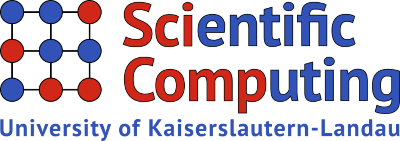Date and Place: Thursdays and hybrid (live in 32-349/online via Zoom). For detailed dates see below!
Content
In the Scientific Computing Seminar we host talks of guests and members of the SciComp team as well as students of mathematics, computer science and engineering. Everybody interested in the topics is welcome.
List of Talks
-
Thu23Oct2025Thu26Feb2026
Prof. Dr. Nicolas Gauger, Chair for Scientific Computing (SciComp), TU Kaiserslautern
SciComp Seminar Series
Please contact Prof. Gauger, if you want to register for an online talk in our SciComp Seminar Series or just to register for the seminar.
A list of the already scheduled talks can be found –> here:
-
Thu27Nov2025
10:15Hybrid (Room 32-349 and via Zoom)
Michael Urs Lars Kastor, Numerical Simulation Group, RPTU Kaiserslautern-Landau
Title: PIDE-model for phenotypic plasticity of glioblastoma
Abstract:
Glioblastoma is the most common aggressive type of brain cancer making up approximatly
14% of tumors originating in the brain. Despite aggressive treatment approaches, tumor
recurrence is most likely due to intra-tumoral phenotypic heterogeneity and plasticity
(the ability to change phenotype), resulting in an average survival time of around
15 months after diagnosis.One potential way to mathematically describe the phenotypic cell development of
glioblastoma is the use of a macroscopic approach via partial integro-differential
equations (PIDEs), whose parameters are fitted based on biological cell data
(e.g. RNA-seq data).In this seminar, first I will briefly outline the central concepts of the biological
background needed to tackle a mathematical explanation of the phenotypic landscape of
glioblastoma, together with different strategies that could be useful for processing
existing datasets and dealing with their high dimensionality and incompleteness.
The talk will then focus on a potentially practical PIDE-model and the associated
parameter identification task.
Finally, the first partial results of the parameter identification on real patient
data in UMAP representation will be presented for a simplified model.How to join online
You can join online via Zoom, using the following link:
https://uni-kl-de.zoom-x.de/j/69269239534?pwd=Z9UOzMpkhMjrxVhll3d49sNHFe9Fd1.1 -
Tue02Dec2025
13:00Room 32-349
The goal of the workshop is to give an overview of recent research activities at SciComp. In addition, collaborators from Fraunhofer ITWM, DFKI, MTU Aero Engines, KIT and TU Eindhoven / Bosch will give invited presentations for scientific exchange. Finally, we will brainstorm about future collaboration.
Program
13:00-15:00 Scientific Short Presentations – SciComp (5+5 minutes each)
(Dr. E. Özkaya, Dr. M. Sagebaum, T. Kortus, O. Burghardt, R. Pochampalli, J. Blühdorn, G. Suarez, Dr. L. Chen, L. Fischer, J. Rottmayer, M. Ngowa Msinda, Dr. A. Linke)15:00-15:15 Coffee break
Keynote Talks
15:15-16:15 Prof. J. Kieseler (KIT)
16:15-17:15 Prof. N. Beishuizen (TU Eindhoven / Bosch)17:15-18:00 Scientific Short Presentations – Guests (10+5 minutes each)
(M. Padmanabha (ITWM), M. Klostermeier (DFKI), C. Battistoni (MTU))18:00-18:30 Brainstorming/Thoughts on Future Collaboration (Prof. N. Gauger)
18:30 Workshop Dinner
